
The BYD B-Box Battery. Is it the perfect B-Boy Beat-Box Battery?
BYD is the world’s largest manufacturer of rechargeable batteries Those three letters stand for Build Your Dreams and apparently their dream was to build a battery box and sell it in Australia because that’s exactly what they’re doing with their B-box battery systems.
There are 2 product lines – the High Voltage1 (HV) and Low Voltage (LV) B-Boxes, each in a variety of storage capacities.
The one most likely to be used for home energy storage is the B-Box LV Residential, which comes in 4 sizes. The smallest being the B-Box 2.5 with 2.45 kilowatt-hours of usable storage and the biggest, the B-Box 10 with 9.8 usable kilowatt-hours.
The B-Box batteries pack more power per kilowatt-hour of storage than almost any other system. Its batteries are lithium iron phosphate, which is the safest lithium chemistry on account of how you have to really screw up big time to set them on fire.
So far BYD has only confirmed a retail price for the B-Box 10 which is $8,734 including GST. Provided its average number of cycles per day is not too low but not more than one, the B-Box 10 will have a warranted cost per kilowatt-hour of 34 cents.
BYD is huge
BYD is a massive Chinese company headquartered in Shenzhen, a city of 12 million immediately north of Hong Kong. Many people have not heard of BYD despite it being bigger than Tesla2. BYD has around 220,000 employees and a market capitalization of about $22 billion. That’s over $900 per Australian. It’s so much money that if I took it all in $100 notes and laid them end to end they’d reach all the way from Melbourne to the loony bin I’d be locked up in. (Darwin.)
BYD manufactures batteries, LED lights, solar panels, trains, and monorails.
They don’t just produce more batteries than Tesla3, they produce the most rechargeable batteries in the world. Or at least they do according to BYD. When someone tells me a figure like that I immediately wonder if they’re talking about number of battery cells produced or total capacity, but either way BYD busts outs batteries by the busload, so they’re definitely not a two-bit battery business.
They are also the world’s largest producer of electric cars, selling around 100,000 in 2016 while Tesla only sold about 76,000. So why has hardly anyone here heard of BYD electric cars? Probably because they kind of suck. In fact, I’d say they suck exactly as much as Japanese cars used to, so we can probably safely ignore them without any repercussions.
In addition to electric cars, BYD also makes electric buses4 and they are going to build 40 of them in Australia.
B-Boxes Use The Safest Lithium Battery Chemistry
The B-Boxes’ batteries are lithium Iron Phosphate. This is the safest lithium chemistry as it is very difficult to get these batteries to overheat and undergo thermal runaway, which is where they uncontrollably raise in temperature and catch fire. Thermal runaway is also known as “venting with flame”.
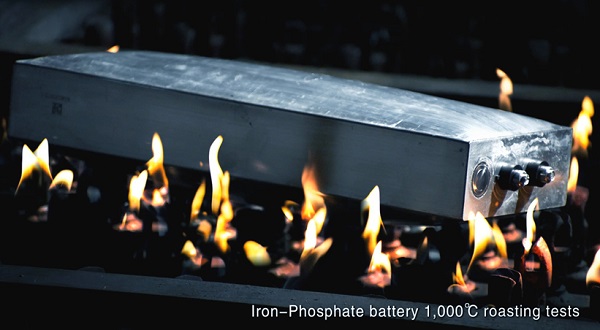
Here we see a BYD lithium iron phosphate battery roasting on an open fire and very conspicuously not venting flame.
If someone tells you lithium iron phosphate batteries are immune to thermal runaway, that’s not true. They simply haven’t tried hard enough. However, as they need a temperature of over 480 degrees to suffer thermal runaway they are much safer than those dangerously unstable lithium batteries we use in our phones and laptops. (I am of course typing this in my laptop enclosure, which is a fire resistant structure separate from my home5.)
Chinese electric cars normally use LiFePO4 (lithium iron phosphate) batteries and not the higher performance NMC (lithium nickle manganese cobalt) batteries used by Tesla and others. This makes Chinese electric vehicles simpler and cheaper – although with reduced performance.
But it does mean China is getting a lot of practice producing lithium iron phosphate batteries which I believe will soon become the cheapest and best for stationary storage.
B-Box LV Residential Specifications
Here’s a table I lifted from a BYD brochure showing technical specifications of the B-Box LV Residential systems.
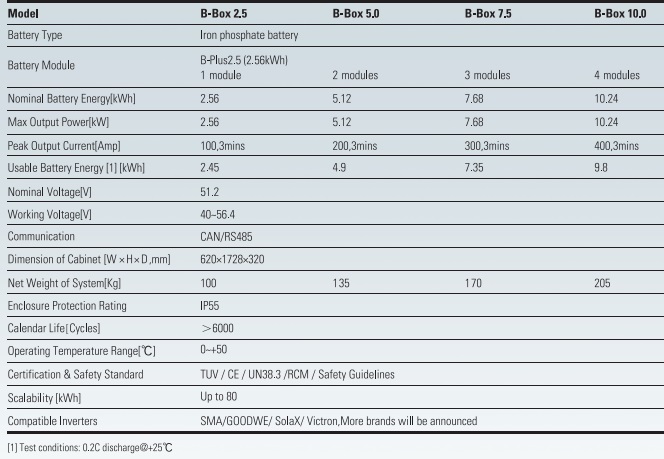
The B-Box LV Residential Needs An Inverter
The B-Box LV Residential is not just a battery. For your money you get lithium iron phosphate batteries, a not very sexy cabinet, and a battery management system. This is a lot better than just a stack of batteries, but it will need a compatible multimode (hybrid) inverter to work.
BYD says compatible inverters are SMA, GoodWe, SolaX, and Victron. We have been told more compatible inverters will be announced soon. Since BYD is a huge company, I think there is an excellent chance this will actually happen.
The correct inverter will allow DC coupling to solar and backup power during blackouts. It can also be AC coupled, although this makes backup more challenging and may even be prohibited due to a silly clause in Australian Standard AS4777.1:2006.
These Are High Power Batteries – Perfect for Tea Drinkers
The B-Boxes have high power output. As far as I know it is only exceeded by the German-made BMZ ESS3.0. The continuous power B-Boxes can supply is equal to their nominal storage capacity. This means the B-Box 10 can give 10.24 kilowatts of power continuously and go from fully charged to flat in a little over 57 minutes. That’s very impressive.
Their peak power is also excellent. They can give twice their continuous output for 3 minutes which is far better than most batteries and long enough to boil the kettle.
When off-grid, it is also useful for starting pumps, air conditioners, and other devices with electric motors.
High power output means less electricity gets drawn from the grid when household demand is high or, if used off-grid, it managing loads is easier. It also gives an advantage to those who can sell electricity to the grid during limited periods of time using a system such as Reposit. More power allows you to sell more electricity during these periods6.
Unfortunately, just how much power the B-Box can supply and how rapidly it can charge is limited by the inverter it is attached to.
B-Box LV Residential: Size, Weight, And Weather Resistance
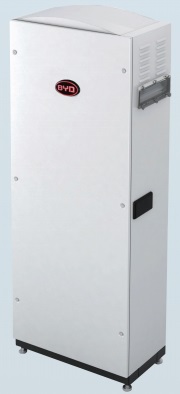
The B-Box LV Residential cabinet: One size fits all. (Provided all is 9.8 kilowatt-hours or less.)
The B-Box LV Residential is not a small battery system. It is 173 cm tall, 62 cm wide, and 32 cm deep. That’s about the height and width of a refrigerator, but only around half the depth. It doesn’t matter whether it is the B-Box 2.5 or the B-Box 10, the cabinet size is the same. Weight starts at 100 kg for the B-Box 2.5 and increases in steps of 35 kg until the B-Box 10 comes in at 205 kg.
This means that, while I am a little taller, I’m not sure I could beat the B-Box 7.5 in a fight because it has a slight weight advantage.
I also have to admit the B-Box cabinet is a lot less sexy than the Powerwall 2 case. But if you find yourself concerned over which battery enclosure is the most sexy, or indeed find them sexy at all, perhaps you should seek professional help. I know I have.
The cabinet’s Ingress Protection rating is IP55, which means it is suitable for indoor or outdoor installation.
Operating Temperature Range Could Be An Issue
BYD’s brochure states the B-Boxes have an operating temperature range from 0 to 50 degrees. If this refers to the temperature of the battery itself, then this makes it suitable for installation almost anywhere in Australia. Even if the air temperature occasionally drops below freezing, the thermal mass of the batteries will prevent them doing the same.
But the B-Box warranty document says that in order for the warranty to apply:
“4.7 The ambient temperature during the operation of the product must not exceed 0 ℃ ~50 ℃ temperature range…”
This is very different, because ambient temperature refers to the local air temperature which means the only capitals where it could be installed outdoors are Darwin, Brisbane, and probably Perth7. The other capitals are too cold in winter, as is central Australia.
Fortunately, lithium iron phosphate batteries are quite capable of safely operating if the ambient temperature is below zero, provided the battery isn’t. So I think it is likely BYD will drop the word “ambient” from their warranty, or at least they will if they want to sell many B-Boxes here.
While lithium iron phosphate batteries are more resistant to deterioration caused by heat than other lithium batteries, it is still a good idea to install it out of direct sunlight.
The B-Box has no fan and no active cooling system. The BYD brochure says it is “nature cooled” which is a term I don’t approve of because it makes me think koalas will come and fan it with palm fronds or bees will gather at its grates and blow air into it with their wings.
As there is no active cooling there is no fan which means it should be completely silent. If it does make noise then you probably have a problem. Maybe a lock picking possum has moved inside. But you can expect any multimode inverter you attach to have a mild hum.
Efficiency? No Idea.
One piece of information BYD doesn’t offer is how efficient their batteries are. I presume this is because it is nothing special. The round-trip efficiency of a lithium iron phosphate battery is typically around 92%. This means for every 100 kilowatt-hours of energy put into the battery 8 kilowatt-hours will be lost. A small amount of energy will also by lost by its multimode inverter, so the overall efficiency might be around 89%.
Higher Voltage And Professional Versions
In addition to the B-Box LV Residential there are two other types – the B-Box HV and the B-Box Professional.
The B-Box HV Needs A Sunny Boy Storage
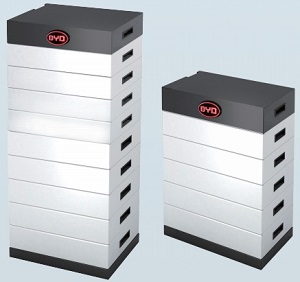
The B-Box HV looks like an electronic beehive or possibly a stack of copier paper.
The B-Box HV has a built in DC converter which means it can accept a higher DC voltage than other B-Boxes. The drawback of this is the only way it can be connected to a home at the moment is with a Sunny Boy Storage battery inverter. While this will allow it to be AC coupled to any home regardless of what kind of inverter the rooftop solar system has8, it limits both charging and discharging of the B-Box HV to 2.5 kilowatts. As the smallest B-Box HV has a continuous power output of 5.6 kilowatts, this means the Sunny Boy Storage won’t even be able to provide half its potential continuous power.
There are 5 B-Box HV models. The smallest has 5.26 kilowatt-hours of usable storage, while the largest has 9.47.
Like the B-Box LV Residential, it can be located indoors or outdoors, but its casing is considerably sexier and looks like an electronic beehive.
The B-Box Professional – Do Not Get Wet
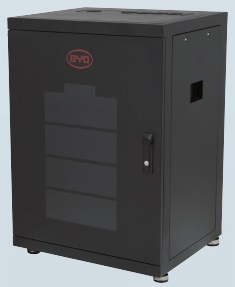
The B-Box Professional.
The B-Box Professional is very similar to the B-Box LV Residential, but its capacity can go one step larger. Also, its cabinet is black and squat and probably the sexiest of the lot.
Unfortunately, with an enclosure protection rating of IP20, it can only be located indoors and cannot be exposed to water at all.
At 88 cm tall, 60 cm wide, and 51 cm deep, it takes up more floorspace than the other two types.
The B-Box Warranty: beware the smallprint
The BYD brochure simply states the B-Box warranty is 10 years without giving any qualifications. Under Australian Consumer Law that means BYD is saying its warranty is 10 years without limits on use. I think BYD will probably want to change this, because its written warranty definitely has limits.
I don’t have warranty information for the B-Box HV or the B-Box Professional, but the B-Box LV Residential is warranted for either 10 years or until it supplies 2,500 kilowatt-hours of stored electricity for each kilowatt-hour of nominal storage. The warranty promises that by its end the B-Box will maintain at least 60% of its original usable capacity.
This graph and table from the warranty document sets it all out:
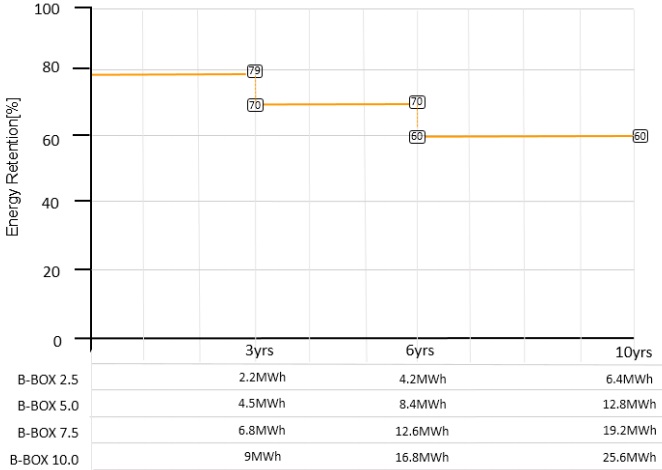
The warranty states BYD will repair or replace defective B-Boxes, or if they no longer make them they will either replace it with something similar or give a pro-rated refund.
The Warranty Limits B-Boxes To One Cycle A Day
Under preconditions, the B-Box LV Residential warranty states:
“4.8 The product can only be installed and operated in household energy storage applications with an average of one full cycle per day… The warranty will be voided if usage exceeds household energy storage applications.”
That is a unique warranty condition and I don’t see how it makes sense, especially if it’s a strict cutoff where they will void your warranty if you average 1.1 cycles a day. It would be even stranger if they decided the condition meant they could void the warranty for averaging below 1 cycle a day. While many people are likely to only cycle their batteries around 0.8 times a day, a higher figure is certainly possible. Reposit says households using their technology on a time-of-use tariff will on average cycle their batteries…
“in excess of 1 and up to 1.3.”
So with their precondition, BYD has basically eliminated all potential customers who want to use Reposit or a similar system that will boost their average cycles per day, and anyone who is simply unsure whether their daily cycles will average above one. While it would be possible to stop using the B-Box for a while if its average cycles were about to go over one, most people are unlikely to find this solution satisfactory.
The one cycle limitation makes no sense because the warranty clearly limits the number of kilowatt-hours stored anyway. Not only do I think BYD have shot themselves in the foot here, I think they’ve done it while standing on a gas main. This is something they are definitely going to have to change.
The Warranty Tries To Sneak In Some Worrying Stuff
Unfortunately there are other things in the warranty that are weird, wrong, and simply not permitted under Australian Consumer Law.
A long list of exemptions under which the warranty doesn’t apply is given and one of them is:
“6.10 The defect cannot be overcome under the technology condition when the products sold to customer.”
I have no idea what the hell that means. I tried using Google Translate on that sentence but all it did was emit quiet sobs.
Perhaps BYD is saying, “If we don’t have the technology to fix a defect, your warranty is no good.” I hope that’s not what they are saying, but I really can’t tell.
Another hilarious corker is they say they can update the warranty from time to time – after you’ve bought the product. NO THEY CAN’T! That is ludicrous!9 There is no way in hell any company can change a written warranty or any kind of warranty after a product has been sold. Not in this country.
Luckily we are always protected by Australian consumer guarantees no matter what a written warranty says.
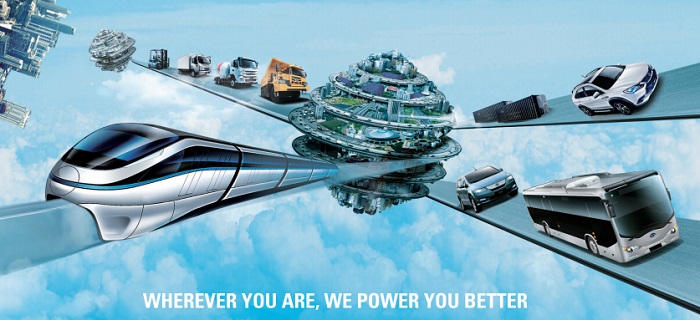
“Wherever you are, we power you better.” – Apparently even if you are in a flying saucer.
Warranted Cost Per Kilowatt-hour – Threading The Needle
BYD has given a price of $8,734 including GST for the B-Box 10. That’s a cost per warranted kilowatt-hour of 34 cents[1. Assuming it deteriorates at a linear rate to 70% of its original usable capacity by the end of its warranty instead of the 60% allowed for, and is cycled from 0.84 to 1 time a day].
If cycled more than once per day its warranty is voided. If cycled less than 0.84 times a day the cost will increase because the warranty will hit its 10 year limit before reaching its maximum warranted stored kilowatt-hours.
So assuming BYD will void your warranty if you cycle it more than an average of once per day, and assuming they won’t void it if you do it less than that, your average cycles will have to fit within a limited zone if you want the lowest warranted cost per kilowatt-hour. Or if you want a warranty at all.
It Won’t Pay For Itself
The B-Box won’t save households money when used for on-grid storage. Its cost of 34 cents per warranted kilowatt-hour is considerably higher than the 23 cents of the still-not-yet-available Powerwall 2 and that does not need a multimode inverter like the B-Box.
But BYD is a huge company and so the B-Box or its successors will likely be around for some time. If they want to be successful they will have to be competitively priced, so provided the Powerwall 2 works as promised10, then I expect BYD will soon lower their prices to give Tesla a run for their money.
Also, they’ll need to remove the weird stuff in their warranty, but I’m sure they’ll get around to that too.
Footnotes
- Or to be technically correct Higher Voltage – as ‘High Voltage’ in Australian Standards terms means over 1500VDC ↩
- But not bigger than Texas. That would be ridiculous. ↩
- Or Panasonic, since that is who Tesla has partnered with to make their batteries. ↩
- There are over 250,000 electric buses in China. ↩
- It also has a fridge and about 800 spiders ↩
- But as the ability to make money this way is quite limited at the moment, it’s unlikely to have much effect on their profitability ↩
- Perth can go for many decades without the temperature falling below zero, but it has happened. ↩
- local regulations re: AS4777.1 permitting ↩
- Actually, it’s so beyond ludicrous it has gone to plaid. ↩
- I believe it is likely to have hidden costs of which we are not yet aware ↩

 RSS - Posts
RSS - Posts



I contacted BYD in the USA office and the guy I talked to said they where only selling utility battery packs. However, on their web site they have these units you write about in this article so there is a definite disconnect in the company. On one hand they have them on their web site and on the other hand they do not sell that product in the USA. So I have crossed them off my list of battery options. My guess is they do not want to get a UL listing. But who knows. I will stick with the nickel iron battery which for some reason you never write about.
Our company has been selling and importing them into the USA market for 22 years. We have had a total of about 20 cell failures in that time after selling many thousands of cells and working with all types of inverters and charge controllers.
Hello John, unfortunately as you have already noticed, with 220,000 employees there is a little bit of a disconnect between divisions in BYD. I’m in charge of the B-box team in the UK and I know we don’t yet have a team in the US but we are creating it right now. Feel free to email me as the B-box will be available in the US before the end of the year.
[email protected]
P.S. Thank you for the interesting review, Ronald.
Love reading the articles here as usual. Can I just suggest you mention installation options when using micro inverters as well? We rarely hear about installations that are using them. Ta.
I am a sales consultant with a small family owned solar company and I can tell you the more than 90% of our installs are done using Enphase Micro Inverters
If converted to USD, this battery is comparable to the 4kWh/4kW batteries BYD were were offering prior to the Powerwall launch, but the enclosure was different.
Unfortunately, Lithium-ion batteries do not survive 10 years of active use, and retain performance. In this case, despite the high power output, warranted capacity is specified at 0.2C to overcome increased series resistance that would lower measured capacity. There are also relaxation periods. The once a day cycle limit is to prevent the battery expiring before
the anode does.
The Powerwall has hidden costs:
AC warranty
https://www.tesla.com/sites/default/files/pdfs/powerwall/Powerwall_2_AC_Warranty_AUS-NZ_1-0.pdf
Listing:
13.2 kWh Powerwall 2 ACPart Number 1108572-xx-x
Energy GatewayPart Number 1099752-xx-x
Backup Energy GatewayPart Number 1109752-xx-x
Energy Gateway MeterPart Number 1112484-xx-x
I meant if scaled for capacity, the price is similar.
Good articles as always but I would like to see you include the approximate installation costs as the PW2 can be up to 5 grand to instal.
Does the B-Box have any instal costs?
THere are a few other companies such as evo lithium that have their own protection built in so just about anyone can instal them for peanuts because they cant be damaged!
Oh for the cost to come down or a cheap pay off option existed, as the wage earner’s can’t afford such luxuries as battery storage. Oh gee…..I so want but cannot afford to….oh me oh my….
“So why has hardly anyone here heard of BYD electric cars? Probably because they kind of suck.”
Hi Ronald, I’m sitting in a hotel room in Hong Kong, having spent the past 9 days in on and around BYD electric cars, buses and factories.
I would say that your statement is patently false. They are a very high quality vehicle, with great range (up to 400km) and are better than any other Chinese made car I have traveled in. (I also own 4 electric vehicles none built by BYD) I would love to own a BYD in Australia, and wonder where you get your information from that they kind of suck?
Hi Rob. I got my information from BYD. They said an e6 costs $80,000 in Australia. I think at that price it sucks. But if they’ve lowered the price I’ll stand corrected and state they have unsucked the e6.
Sarcasm: the use of irony to mock or convey contempt. “they suck exactly as much as Japanese cars used to, so we can probably safely ignore them without any repercussions”
So, you’re saying it sucks purely based on a price judgement. That’s fine, it wasn’t very clear in your article. I also wasn’t aware the e6 was available in Australia.
BYD is now selling the e6 in Australia. It’s the only car they’ve sold here. They say they are looking for fleet buyers but will also sell to private individuals. I’m sure the price will come down.
If anyone wants me to review an electric car on the details of its performance, I am more than happy to do that. Just drop it off at my place and I’ll soon have an article on how well it handles, whether or not it can outrun police vehicles, how well it survives impact, and how suitable it is in a pinch for transporting horses.
Ronald, they should be able to keep up with police vehicles since the BYD e6 is used as police cars in Shenzhen. I love your articles, but I too was a tad disappointed to read the “suck” comment. The e6 is an amazing vehicle. I first saw them in SZ about 6 years ago when BYD introduced 40 of them as Taxis. There are now apparently around 1800 of them and as mentioned so successful are they, that the police are using them too. Now, if there ever was a perfect test for an electric vehicle (range, cost, charge time, reliability, comfort, performance) then use the EV as a Taxi. Nothing more needs to be said. As for the price, BYD subsidise them for the Taxi drivers/companies by allowing them to be paid over 5 years. The payments (I am told) equal the amount they would otherwise be paying for fossil fuels and therefore the Taxi owner seems to get a “free” car in the 5 year payback term. The price in SZ used to equate to around 45K so the price in Australia makes no sense to me at all. When in SZ I go out of my way to flag down an EV Taxi as opposed to a petrol one. It makes economic good sense since they are 2 RMB cheaper as no petrol fare surcharge is required. Australia has been slow to embrace EV’s, but it will happen, and quite fast at that. I would not recommend anyone buy a new car from now on, since I suspect that well within the 5 (and even 7) year warranty period offered by some manufacturers, your petrol vehicle will be worth scrap value only. You can’t make gasoline on your roof (not legally in most states anyway) but you can power your EV. It is seldom discussed, but as soon as there are 10% EV’s on the road there will be 10% less petrol stations, and all of a sudden, it will be the fully internal combustion engine drivers turn to suffer range anxiety.
I’m not the only one then to assume that saying a product ‘sucks’ means it’s of low quality. I feel you’re doing the company a disservice to leave this questionable statement in the article.
That was my thoughts, but he appears to be lost on a strange tangent.
So who’s selling them in Oz? or rAdelaide specifically?
Still like the Zcell better
So, I currently have 19 solar panels on my roof, producing a tad below 5k/w hours at it’s peak. What would be the cost of one of these BYD units “installed” in my garage and what unit would be best for my use, bearing in mind there are only 2 of us living in this home.
Hello Stuart. I’m afraid I can’t say what size unit may be best for you without knowing what your goal is.
If your goal is to save money on your electricity bills I’m afraid none of them will do that at the moment. Batteries need to come down in price before they’ll pay for themselves.
If you want to have power during blackouts, then a generator is likely to be a cheaper option and also more reliable as it won’t be affected by prolonged periods of cloudy weather.
But if you want batteries for non-economic reasons, then the smallest 2.5 kilowatt-hour B-Box may be able to run lights, a TV, a refrigerator, and a freezer overnight, while with larger B-Boxes you could potentially run an air conditioner and/or other appliances.
I don’t have any information on what people have paid to get B-Boxes installed, so what I tell you is only a guess, but you may have to pay well over $14,000 for an installed 10 kilowatt-hour B-Box.
With Zcell 10 kW unit giving 10 years warrantee Run flat NO PROBLEMO! leave it unused for long periods NO PROBLEMO! what have we got to lose? So far price will not pay for itself in 7 years, when price get to the 7 year payback I may buy one. in the meantime I have my good bank of gel cells.
Actually 1 PROBLEMO, you need 2x ZCell in a pair connected to an inverter. And the cost per hWhr is higher. Whilst the technology is better in some regards, even overseas manufacturing has not helped here.
Redflow / ZCell need to think about scales of economy here and get a decent backer to help them buy some market share by reducing their margins for a period time, once the customer base and feedback has grown, then start charging like a wounded bull. Till then your just a more expensive battery with a lot of parts that can fail and require maintenance and a similar warranty on a company that has fragile funding and and cash flow, that may have been taken to market too soon